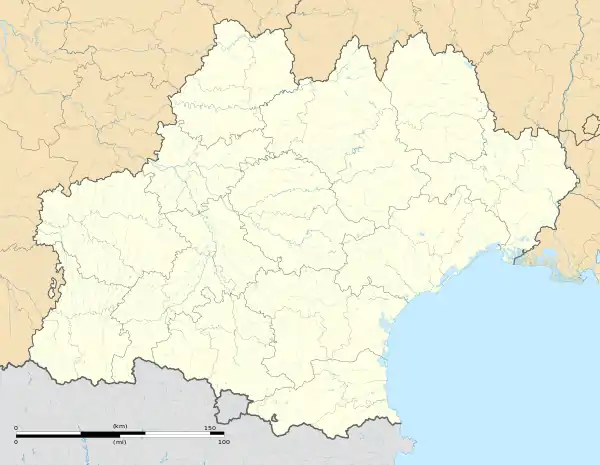Luc-la-Primaube
Luc-la-Primaube is a commune in the Aveyron department in southern France, in Occitanie, 10 kilometres south of Rodez. Its inhabitants are called Lucois or Primaubois, after the two towns in the commune, Luc and La Primaube, which are 3 km (1.9 mi) apart.
Luc-la-Primaube | |
|---|---|
 The church in Luc-la-Primaube | |
Location of Luc-la-Primaube 
| |
 Luc-la-Primaube  Luc-la-Primaube | |
| Coordinates: 44°18′53″N 2°32′09″E | |
| Country | France |
| Region | Occitanie |
| Department | Aveyron |
| Arrondissement | Rodez |
| Canton | Nord-Lévezou |
| Intercommunality | Rodez |
| Government | |
| • Mayor (2014–2020) | Jean-Philippe Sadoul (PR) |
| Area 1 | 26.85 km2 (10.37 sq mi) |
| Population (2017-01-01)[1] | 5,969 |
| • Density | 220/km2 (580/sq mi) |
| Time zone | UTC+01:00 (CET) |
| • Summer (DST) | UTC+02:00 (CEST) |
| INSEE/Postal code | 12133 /12450 |
| Elevation | 514–740 m (1,686–2,428 ft) (avg. 630 m or 2,070 ft) |
| 1 French Land Register data, which excludes lakes, ponds, glaciers > 1 km2 (0.386 sq mi or 247 acres) and river estuaries. | |
Commune name
Luc-la-Primaube was called Luc until September 12, 2005. The new name was made official by the decree n° 2005-1155 of the bearing September 12, 2005 name change of communes (NOR: INTA0500236D) published in the official journal n° 215 of September 15, 2005 page 14,945.
Towns
Luc is a small town where the commune's town hall is located. La Primaube is a commercial small town built on flat ground, without river or hill, which has a church with a bell-tower, and a commercial area with fountains.
History
The history of Luc-la-Primaube is related to the old parish of Capelle Saint-Martin, which was formerly under the domination of the abbey of Bonnecombe. The relic of Saint-Martin once brought many people to the parish to cure the disease known as "worms". Today the relic is located at the Sainte-Anne old people's home.
| Year | Pop. | ±% |
|---|---|---|
| 1793 | 611 | — |
| 1800 | 631 | +3.3% |
| 1831 | 1,023 | +62.1% |
| 1836 | 1,025 | +0.2% |
| 1841 | 1,056 | +3.0% |
| 1846 | 1,093 | +3.5% |
| 1851 | 1,114 | +1.9% |
| 1856 | 1,160 | +4.1% |
| 1861 | 1,176 | +1.4% |
| 1866 | 1,171 | −0.4% |
| 1872 | 1,154 | −1.5% |
| 1876 | 1,170 | +1.4% |
| 1881 | 1,166 | −0.3% |
| 1886 | 1,241 | +6.4% |
| 1891 | 1,294 | +4.3% |
| 1896 | 1,315 | +1.6% |
| 1901 | 1,369 | +4.1% |
| 1906 | 1,398 | +2.1% |
| 1911 | 1,399 | +0.1% |
| 1921 | 1,319 | −5.7% |
| 1926 | 1,305 | −1.1% |
| 1931 | 1,330 | +1.9% |
| 1936 | 1,410 | +6.0% |
| 1946 | 1,241 | −12.0% |
| 1954 | 1,238 | −0.2% |
| 1962 | 1,428 | +15.3% |
| 1968 | 1,864 | +30.5% |
| 1975 | 2,613 | +40.2% |
| 1982 | 3,674 | +40.6% |
| 1990 | 4,036 | +9.9% |
| 1999 | 4,719 | +16.9% |
| 2008 | 5,544 | +17.5% |
See also
References
- "Populations légales 2017". INSEE. Retrieved 6 January 2020.
| Wikimedia Commons has media related to Luc-la-Primaube. |